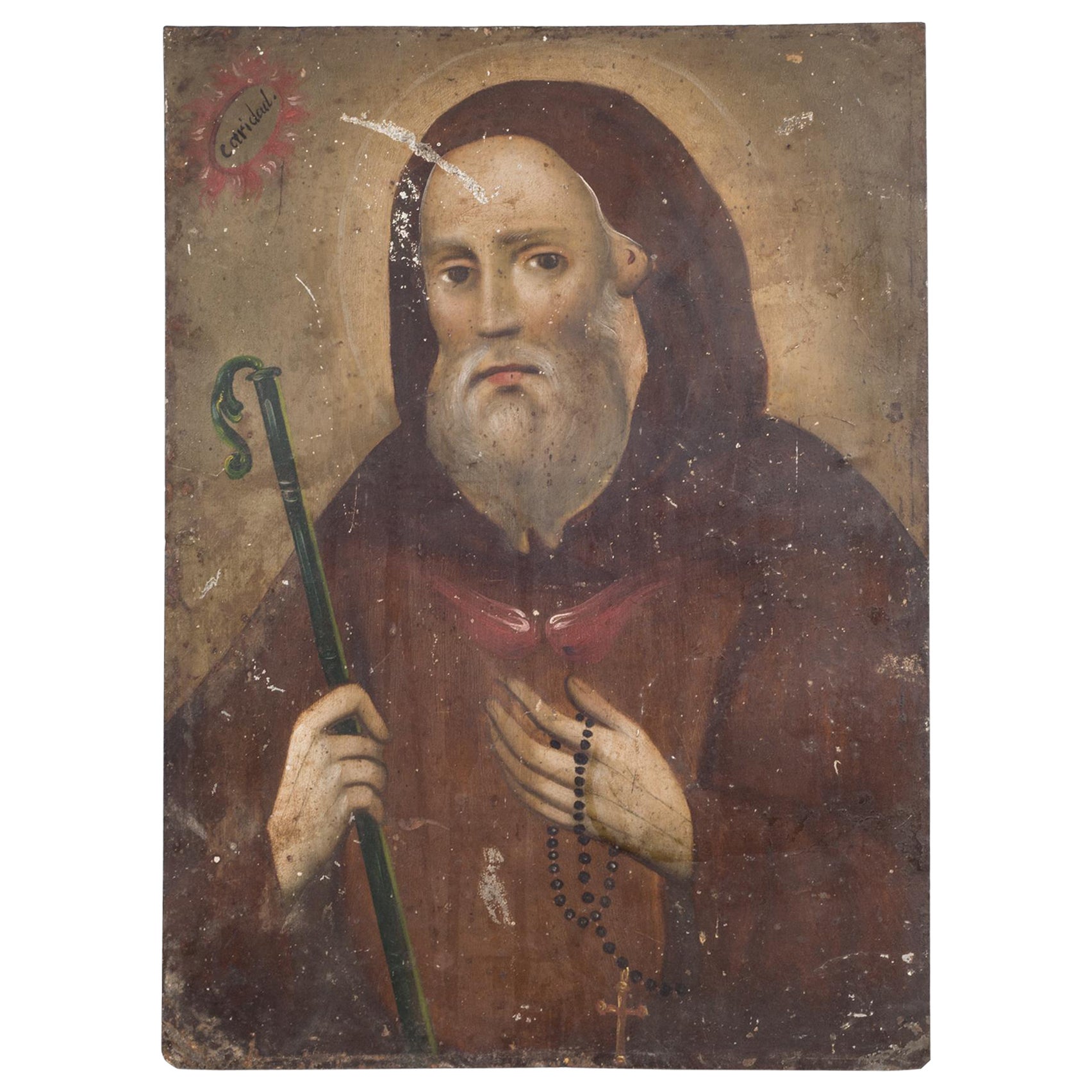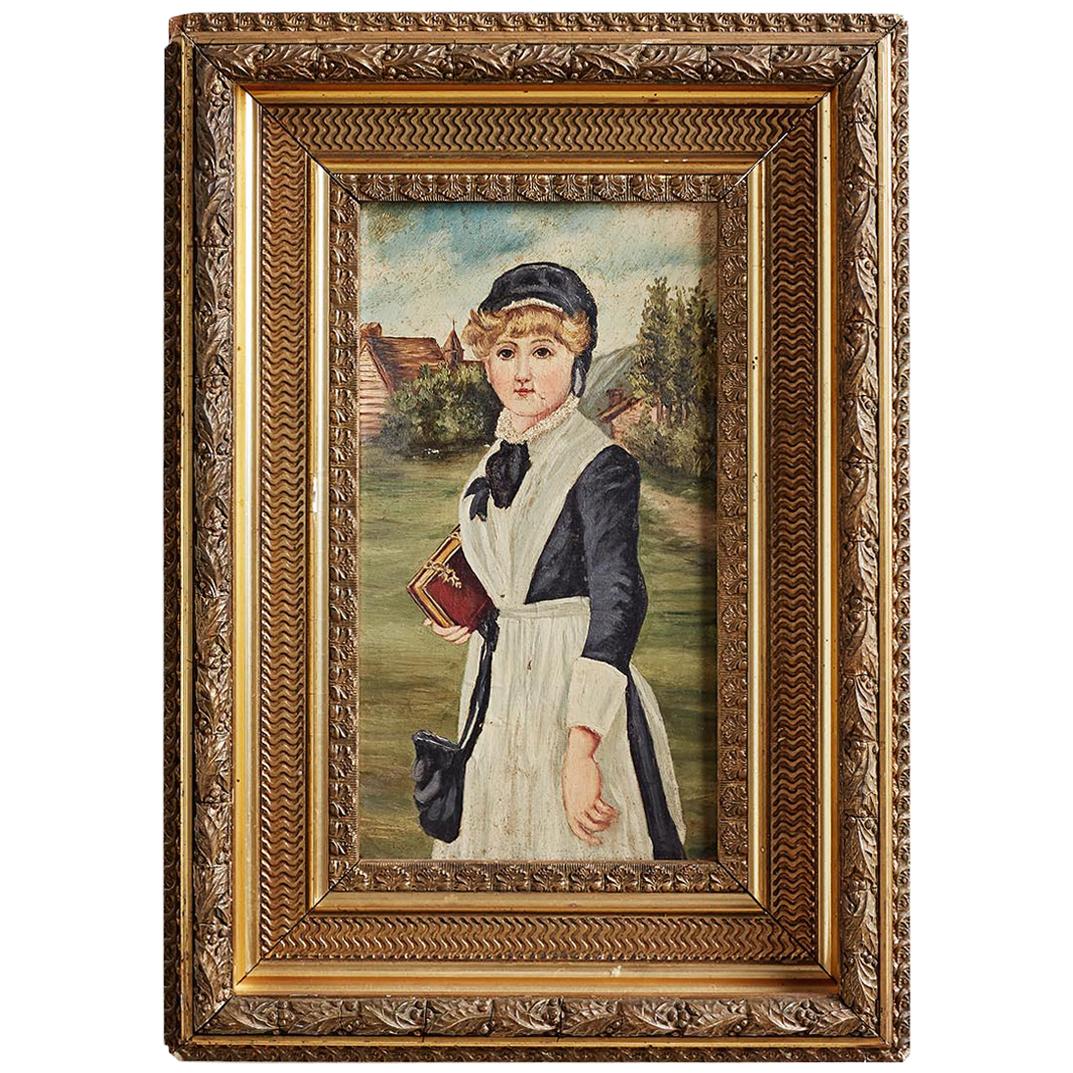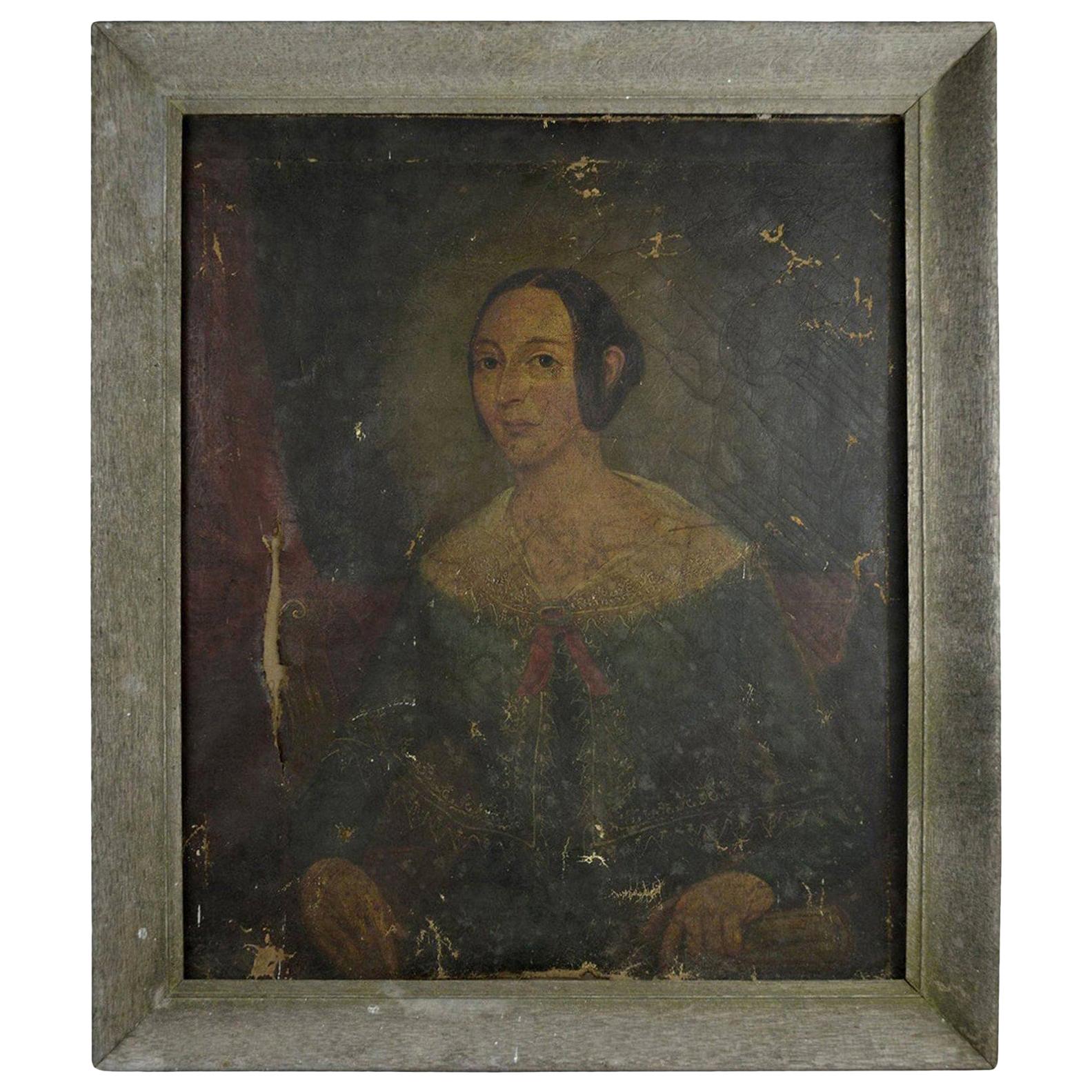Items Similar to 19th C. Mexican Retablo "Veronica's Veil", c.1880
Want more images or videos?
Request additional images or videos from the seller
1 of 5
19th C. Mexican Retablo "Veronica's Veil", c.1880
About the Item
About
An original 19th century Mexican folk retablo "Veronica's Veil" or "El Divono Rostro" in Spain . Oil paint on tin.
The Veil of Veronica, known in Italian as the Volto Santo or Holy Face, is a Roman Catholic Relic which, according to legend, bears the likeness of the Face of Jesus that was imprinted on it prior to Jesus' crucifixion. According to Roman Catholicism, Saint Veronica encountered Jesus in Jeruselum on the way to Calvary. When she paused to wipe the sweat (Latin, suda) off his face with her veil, his image was left on the veil.
In the small village of Osa de la Vega in Spain, there lived a couple who led a very pious life. They were Gregorio de la Torre and Isabel Corral. From their father, Juan Montilla, they inherited a picture of the Face of Jesus or the Divino Rostro. A story that is told one day, to the amazement of many who confirmed its veracity, the picture began to perspire with living blood. News of this extraordinary event spread swiftly and widely throughout the land.
CREATOR Unknown.
DATE OF MANUFACTURE c.1880.
MATERIALS AND TECHNIQUES Oil Paint on Tin.
CONDITION Good. Wear consistent with age and use.
DIMENSIONS H 14 in. W 10 in.
HISTORY
Retablos, better known as 'laminas' in Mexico, are small oil paintings on tin, wood and sometimes copper which were used in home altars to venerate the almost infinite number of Catholic saints. The literal translation for 'retablo' is 'behind the altar.' This unique genre of art, deeply rooted in European history, was brought to Mexico with the arrival of the Spanish and then ultimately adopted by New World mestizo natives to become what is known today as the Mexican folk retablo.
The retablo was an art form that flourished in post conquest Mexico and then ultimately, with the introduction of inexpensive mediums such as tin, reached its pinnacle of popularity in the last quarter of the 19th century. With some exceptions, mostly untrained artists from the provinces worked to produce and reproduce these sacred images; some subjects painted more prolifically than others. A typical "retablero" may have reproduced the same image hundreds, if not thousands of times in his or her career.
These oil paintings were sold to devout believers who displayed them in home altars to honor their patron saints. There are virtually hundreds of saints, each invoked to remedy a different situation. "San Ysidro Labrador," the patron saint of farmers, is venerated for good weather, agricultural issues and prosperous crop. He is often called upon before picnics or just before harvest. Having spent four years in the forest as a hermit, San Jeronimo, the patron saint of scholars and philosophers, is invoked for protection against temptations and want.
Bearing some semblance to retablos, 'ex-votos' are devotional paintings on canvas or tin which offer thanks to a particular saint in the form of a short narrative. In many events, a small child becomes ill, a soldier returns safely from war, or a favorite animal is reunited with its owner. The petitioner, grateful for this miracle, dedicated a small painting (with a short testimonial) to the respective patron Saint.
These unique art forms are a hybrid of centuries old Catholic iconography and indigenous artistry; reflecting the historical, cultural and religious links between "old" and "new" worlds.
- Dimensions:Height: 14 in (35.56 cm)Width: 10 in (25.4 cm)Depth: 0.2 in (5.08 mm)
- Style:Folk Art (Of the Period)
- Materials and Techniques:
- Place of Origin:
- Period:
- Date of Manufacture:1880
- Condition:Wear consistent with age and use.
- Seller Location:San Francisco, CA
- Reference Number:1stDibs: LU1280227920942
About the Seller
5.0
Platinum Seller
These expertly vetted sellers are 1stDibs' most experienced sellers and are rated highest by our customers.
Established in 2014
1stDibs seller since 2015
1,141 sales on 1stDibs
Typical response time: <1 hour
- ShippingRetrieving quote...Ships From: San Francisco, CA
- Return PolicyA return for this item may be initiated within 7 days of delivery.
More From This SellerView All
- 19th c. Mexican Retablo "Veronica's Veil" c.1880Located in San Francisco, CAABOUT An original 19th century Mexican folk retablo "Veronica's Veil" or "El Divono Rostro" in Spain . Oil paint on tin. The Veil of Veronica, known in Italian as the Volto Santo or Holy Face, is a Roman Catholic Relic which, according to legend, bears the likeness of the Face of Jesus that was imprinted on it prior to Jesus' crucifixion. According to Roman Catholicism, Saint Veronica encountered Jesus in Jeruselum on the way to Calvary. When she paused to wipe the sweat (Latin, suda) off his face with her veil, his image was left on the veil. In the small village of Osa de la Vega in Spain, there lived a couple who led a very pious life. They were Gregorio de la Torre and Isabel Corral. From their father, Juan Montilla, they inherited a picture of the Face of Jesus or the Divino Rostro. A story that is told one day, to the amazement of many who confirmed its veracity, the picture began to perspire with living blood. News of this extraordinary event spread swiftly and widely throughout the land. CREATOR Unknown. DATE OF MANUFACTURE c.1880. MATERIALS AND TECHNIQUES Oil Paint on Tin. CONDITION Good. Wear consistent with age and use. DIMENSIONS H 14 in. W 10 in. HISTORY Retablos, better known as 'laminas' in Mexico, are small oil paintings on tin, wood and sometimes copper which were used in home altars to venerate the almost infinite number of Catholic saints. The literal translation for 'retablo' is 'behind the altar.' This unique genre of art, deeply rooted in European history, was brought to Mexico with the arrival of the Spanish and then ultimately adopted by New World mestizo natives to become what is known today as the Mexican folk retablo. The retablo was an art form that flourished in post conquest Mexico and then ultimately, with the introduction of inexpensive mediums such as tin, reached its pinnacle of popularity in the last quarter of the 19th century. With some exceptions, mostly untrained artists from the provinces worked to produce and reproduce these sacred images; some subjects painted more prolifically than others. A typical "retablero" may have reproduced the same image hundreds, if not thousands of times in his or her career. These oil paintings were sold to devout believers who displayed them in home altars to honor their patron saints. There are virtually hundreds of saints, each invoked to remedy a different situation. "San Ysidro Labrador," the patron saint of farmers, is venerated for good weather...Category
Antique 19th Century Mexican Folk Art Paintings
MaterialsTin
- 19th C. Mexican Retablo, C.1880Located in San Francisco, CAABOUT An original 19th century Mexican folk retablo. Oil paint on tin. Subject unknown. CREATOR Unknown. DATE OF MANUFACTURE c.1880. MATERIALS AND TECHNIQUES Oil Paint on Tin. CONDITION Good. Wear consistent with age and use. DIMENSIONS H 14 in. W 10 in. HISTORY Retablos, better known as 'laminas' in Mexico, are small oil paintings on tin, wood and sometimes copper which were used in home altars to venerate the almost infinite number of Catholic saints. The literal translation for 'retablo' is 'behind the altar.' This unique genre of art, deeply rooted in European history, was brought to Mexico with the arrival of the Spanish and then ultimately adopted by New World mestizo natives to become what is known today as the Mexican folk retablo. The retablo was an art form that flourished in post conquest Mexico and then ultimately, with the introduction of inexpensive mediums such as tin, reached its pinnacle of popularity in the last quarter of the 19th century. With some exceptions, mostly untrained artists from the provinces worked to produce and reproduce these sacred images; some subjects painted more prolifically than others. A typical "retablero" may have reproduced the same image hundreds, if not thousands of times in his or her career. These oil paintings were sold to devout believers who displayed them in home altars to honor their patron saints. There are virtually hundreds of saints, each invoked to remedy a different situation. "San Ysidro Labrador," the patron saint of farmers, is venerated for good weather...Category
Antique 19th Century Mexican Folk Art Paintings
MaterialsTin
- 19th C. Mexican Retablo Saint Francis c.1880Located in San Francisco, CAAbout An original 19th century Mexican folk retablo of Saint Francis. Oil paint on tin. St. Francis of Assisi, Italian San Francesco d’Assisi was born 1181-1182 in Assisi, duchy of Spoleto, Italy and died October 3, 1226. He was canonized July 16, 1228. He founded the Franciscan orders of the Friars Minor and the lay Third Order. He was also a leader of the movement of evangelical poverty in the early 13th century. His evangelical zeal, consecration to poverty, charity, and personal charisma drew thousands of followers. Francis’s devotion to the human Jesus and his desire to follow Jesus’ example reflected and reinforced important developments in medieval spirituality. Cretor Unknown. Date of manufacture c.1880. Materials and techniques Oil Paint on Tin. Condition Good. Wear consistent with age and use. Dimensions H 14 in. W 10 in. History Retablos, better known as 'laminas' in Mexico, are small oil paintings on tin, wood and sometimes copper which were used in home altars to venerate the almost infinite number of Catholic saints. The literal translation for 'retablo' is 'behind the altar.' This unique genre of art, deeply rooted in European history, was brought to Mexico with the arrival of the Spanish and then ultimately adopted by New World mestizo natives to become what is known today as the Mexican folk retablo. The retablo was an art form that flourished in post conquest Mexico and then ultimately, with the introduction of inexpensive mediums such as tin, reached its pinnacle of popularity in the last quarter of the 19th century. With some exceptions, mostly untrained artists from the provinces worked to produce and reproduce these sacred images; some subjects painted more prolifically than others. A typical "retablero" may have reproduced the same image hundreds, if not thousands of times in his or her career. These oil paintings were sold to devout believers who displayed them in home altars to honor their patron saints. There are virtually hundreds of saints, each invoked to remedy a different situation. "San Ysidro Labrador," the patron saint of farmers, is venerated for good weather...Category
Antique 19th Century Mexican Folk Art Paintings
MaterialsTin
- 19th c./Early 20th c. Oil on Canvas PaintingLocated in San Francisco, CAOil on canvas. 19th-early 20th century Unsigned. Unframed. CONDITION: Good. Wear consistent with age and use. Loss of paint on the lower left corner. Large indented area on left side.Category
Early 20th Century Victorian Paintings
MaterialsWood, Paint
- 19th c. Oil Portrait of a Bearded Gentleman, c.1800sLocated in San Francisco, CAABOUT An original oil on canvas painting of a bearded gentleman. Signed on back on upper frame. The artwork is unframed and has maintained its color with the appropriate wear consis...Category
Antique 19th Century Victorian Paintings
MaterialsWood, Paint
- American 19th c. Oil Portrait of a Gentleman, c.1800sLocated in San Francisco, CAABOUT A 19th century oil portrait on canvas of a gentleman. Unsigned. CREATOR Unknown. DATE OF MANUFACTURE c.1800s. MATERIALS AND TECHNIQUES Oil on Canvas. Unframed. ...Category
Antique 19th Century Victorian Paintings
MaterialsWood, Paint
You May Also Like
- 19th Century Mexican Religious RetabloLocated in Ross, CAAntique Mexican retablo made in 1890 which includes a woman praying to the Virgin Mary and Jesus Christ. Framed in wooden frame ornately carve...Category
Antique 1890s Mexican Folk Art Paintings
MaterialsTin
- 19th Century Folk Art Painting of a Young GirlLocated in Rio Vista, CAInteresting 19th century Folk Art painting of a young girl holding a bible. Oil on canvas with a treed landscape and blue sky. Set in a deep carved giltwood frame with repeating bord...Category
Antique 19th Century European Folk Art Paintings
MaterialsWood, Canvas
- Naive Portrait of a Girl, English, Early 19th CenturyLocated in St Annes, LancashireWonderful naive oil painting of a girl. Fabulous muted colors. The austerity of the image is matched by the simplicity of the antique bleached oak frame. I have chosen not to r...Category
Antique 1840s English Folk Art Paintings
MaterialsCanvas, Oak
- Danish Early 19th Century Oil Painting Of A Farm HouseLocated in Haddonfield, NJDanish early 19th Century oil painting of a farm house in a period gilded frame.Category
Antique Early 19th Century Danish Folk Art Paintings
MaterialsCanvas, Wood
- Swedish 19th Century Folk Art Oil Painting With KidsLocated in Haddonfield, NJSwedish naive oil painting with the original frame, from the 2nd part of the 19th Century. This folk art work on canvas represents kids and a dog playing by a courtyard, opening the...Category
Antique Late 19th Century Swedish Folk Art Paintings
MaterialsCanvas, Wood
- 19th C Framed Fraktur Watercolor PaintingLocated in Los Angeles, CABeautiful 19th C Fruktur by Martha Geist The poem on the Fruktur (watercolor) is re-written below. "If my name heaven is my station, This world is my habitation. Christ is my ...Category
Antique 19th Century American Country Paintings
MaterialsWood
Recently Viewed
View AllMore Ways To Browse
New Mexico Furniture
New Mexican Furniture
Antique Mexico
Antique Mexican
Mexican Antique
Antique Mexican Furniture
Antique Mexican Furniture Furniture
Mexican Antique Furniture
Folk Art Face
19th Century Mexican
19th Century Mexico
Just Folk
Spain Mexico Furniture
Mexican Spanish
Spanish Mexican Furniture
19th Century Mexican Furniture
Folk Art Weather
Antique Tin Art





